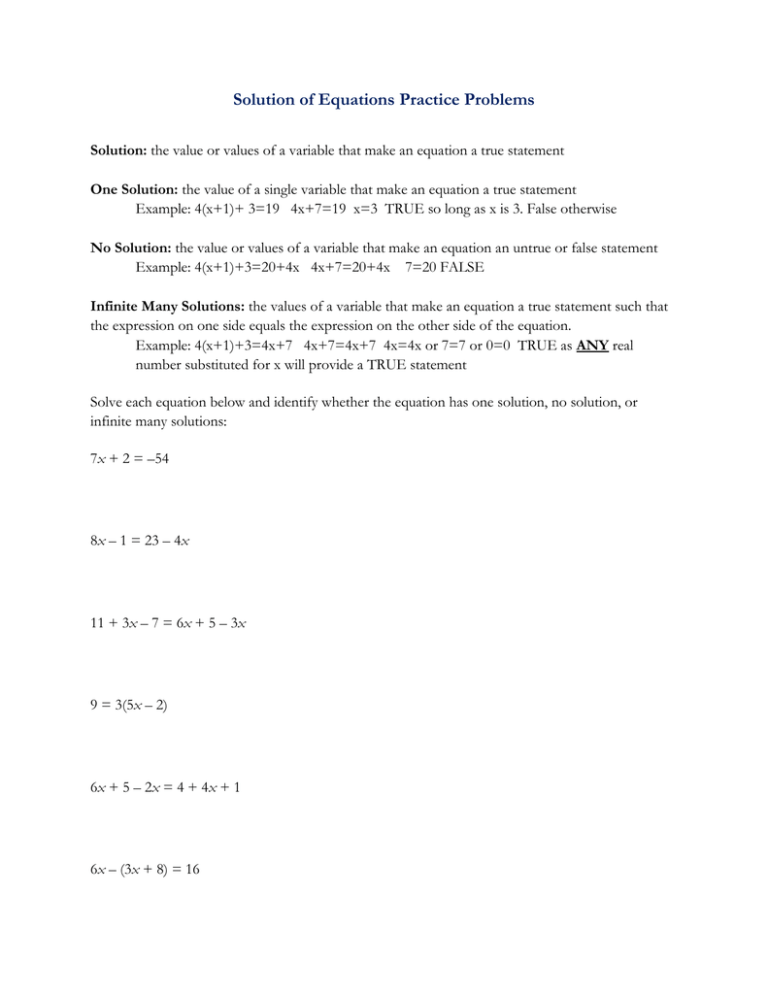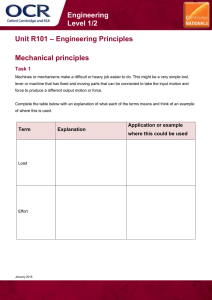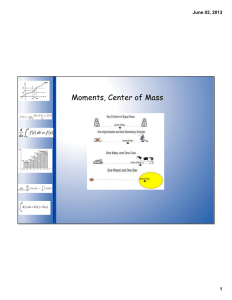Solution of Equations Practice Problems
advertisement

Solution of Equations Practice Problems Solution: the value or values of a variable that make an equation a true statement One Solution: the value of a single variable that make an equation a true statement Example: 4(x+1)+ 3=19 4x+7=19 x=3 TRUE so long as x is 3. False otherwise No Solution: the value or values of a variable that make an equation an untrue or false statement Example: 4(x+1)+3=20+4x 4x+7=20+4x 7=20 FALSE Infinite Many Solutions: the values of a variable that make an equation a true statement such that the expression on one side equals the expression on the other side of the equation. Example: 4(x+1)+3=4x+7 4x+7=4x+7 4x=4x or 7=7 or 0=0 TRUE as ANY real number substituted for x will provide a TRUE statement Solve each equation below and identify whether the equation has one solution, no solution, or infinite many solutions: 7x + 2 = –54 8x – 1 = 23 – 4x 11 + 3x – 7 = 6x + 5 – 3x 9 = 3(5x – 2) 6x + 5 – 2x = 4 + 4x + 1 6x – (3x + 8) = 16 7(5x – 2) = 6(6x – 1) Essential Question: How can I apply and benefit from a practical real life use of solving linear equations in one variable and visually, physically, and algebraically understand and relate to the outcomes. For additional support and interactive review and practice, visit: http://learnzillion.com/student/lessons/1005-understand-a-linear-equation-with-one-solution http://www.purplemath.com/modules/solvelin.htm Interactive: http://www.mathway.com/signup.aspx?pr=affil42656 Teeter Totter Task Activity CCGPS Standards MCC8.EE.7: Solve linear equations in one variable. MCC8.EE.7a: Give examples of linear equations in one variable with one solution, no solutions or infinitely many solutions. Essential Question: How can I apply and benefit from a practical real life use of solving linear equations in one variable and visually, physically, and algebraically understand and relate to the outcomes? Activity Assignment: You will break up into the assigned small groups to complete the activity below. During the activity, keep notes of your findings so that each student will be able to write an assignment summary report answering the listed questions and providing any other findings or conclusions you obtained from the activity. The final paragraph on your paper should provide your answer to the essential question. Your paper should include complete sentences and clearly communicate your views. Your assignment will be graded consistent with the rubric. Materials for each group: One 2” x 4” x 8’, 2 strips of ½”x ½” wood, 1 pre-made fulcrum, measuring tape, ruler, nails, hammer, pencil, and paper, calculator (optional) Activity: To construct a teeter totter using the above materials, experiment with weights for balance, connect the standards to the activity, and write a summary report of what you have learned including a final paragraph that answers the essential question. Roles and Responsibilities: Each small group will have no more than four students. After you construct the teeter-totter, I will assign one student for each of the following roles: Student One: Manage and keep the board in place on the fulcrum to ensure balance before weight placement Student Two: Manage the placement of the weight on the right side Student Three: Manage the placement of the weight on the left side Student Four: Maintain the reporting, finding, and notes. Step 1: Find the center of the 8 foot 2” x 4” (Do not assume it is at the 4’ mark), and draw a line across both sides of the 4’ side of the board. Measure out 3/8” from both sides of this line on one side of the 2” x 4”, and draw another line parallel to the first. These measurements should give you an area that is 3/4” wide and is located exactly in the center of your board. Step 2: With two nails for each ½” x ½” strip, nail the two strips to the 2” x 4” with the inside edge of each against the marked lines so that a ¾” gap exists on the face of the 2” x 4” between the strips. This provides a slot for the teeter totter to fit on the pre-made fulcrum. Step 3: Using a measuring tape or a ruler and starting from the center mark on your 2” x 4,” mark and label increments of 1” making sure you also identify each foot measure as well (So 12” will also be identified at 1’, 24” as 2’, etc.). Do this in both directions on your 2” x 4” so that there is an equal but opposite measure on both sides of the fulcrum slot. Step 4: Take a pre-made fulcrum and set up your teeter totter and test to ensure it is balanced when set on the fulcrum. You will be able to adjust slightly due to the width of the fulcrum slot but you may have to add some small scrap wood pieces to one side. It is best to use small pieces of wood and attach toward the far end of the 2” x 4” away from the fulcrum. Step 5: Get two different weights. Put them on opposite sides and various distances away from the fulcrum in an attempt to balance the teeter totter. Chart your weight and original distances on the attached sheet. Make another attempt by estimation and chart that attempt as well. Finally, create an equation that can be used to solve for the correct distance to allow for balance and determine what revisions are needed to your attempted distances to obtain balance. Repeat this at least three times using various weight and distance combinations. Complete the chart with both your estimation findings and concluding each combination by providing a written equation that allows you to solve for balance. Teeter Totter Activity Data Sheet Left Side Right Side Notes ^ Force (weight) lbs Example: 20 lb 20 lb #1 Findings x Distance = x 36” x 36” x x x #1 Equation/Solution: #2 Findings x x x #2 Equation/Solution: #3 Findings x x x #3 Equation/Solution: ^ Force (weight) lbs x Distance = 60 lb 60lb x 12” 40” = = 720 720 = = = ^ ^ ^ x x x = = = = = = ^ ^ ^ x x x = = = = = = ^ ^ ^ x x x = = = 720 2400 Example- Solution Example- No Solution Write the equation in the line below the scenario that is used and solve for the variable to obtain balance. 100 lbs x 72” = 7200 ^ 400 x D = 7200 D= 200 lbs x 18” = 3600 ^ 400 x D = D= W x 48” = ^ 200 x 2 feet = 150 x 30” = ^ W x 90” = W= 100 x (D+20) = ^ 200 x D = D= (W+90) x 20 = ^ W x 50 = W= 400 W= Teeter Totter Activity Summary Report Questions Were you able to make the teeter totter balance using only one weight? Explain why or why not? What do you see happening as you initially place the weights on the teeter totter? Does the lighter weight ever lift the heavier weight up? Explain why you think this can or cannot occur? Do you see any correlation between weight and distance? If so, explain. How did you create the equation to solve for the single variable? Should the solution always cause balance? Are there any other factors that could affect the outcome? Would there be a solution to the equation if the teeter totter is not balanced? How can you prove when there is no solution? Write the equations that would represent the following word problem and solve it. It may be helpful to review the final two scenarios on your data chart. John weighs 90 pounds more than Robert. If John stands 20 feet from the fulcrum and Robert stands 50 feet from the fulcrum and they balance, how much do both John and Robert weigh? Sally weighs 100 pounds and her mother weighs 200 pounds. If Sally has to stand 20 feet further from the fulcrum for her to balance her mother, how far do each of them have to stand away from the fulcrum? Heather weighs 120 pounds and Kelly weighs 150 pounds. If Heather sits 20 inches further from the fulcrum than Kelly who is sitting 50 inches from the fulcrum, will they be balanced? Answer the essential question referencing the information and knowledge you gained from the activity. Essential Question: How can I apply and benefit from a practical real life use of solving linear equations in one variable and visually, physically, and algebraically understand and relate to the outcomes?


